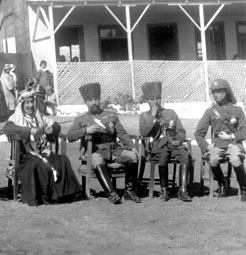 |
Keys
to the Kingdom National Anthem The Office History |
|
Although the Sykes-Picot Agreement was modified considerably in practice, it established a framework for the mandate system which was imposed in the years following the war. Near the end of 1918, the Hashemite Emir Faisal set up an independent government in Damascus. However, his demand at the 1919 Paris Peace Conference for independence throughout the Arab world was met with rejection from the colonial powers. In 1920 and for a brief duration, Faisal assumed the throne of Syria and his elder brother Abdullah was offered the crown of Iraq by the Iraqi representatives. However, the British government ignored the will of the Iraqi people. Shortly afterward, the newly-founded League of Nations awarded Britain the mandates over Transjordan, Palestine and Iraq. France was given the mandate over Syria and Lebanon, but had to take Damascus by force, removing King Faisal from the throne to which he had been elected by the General Syrian Congress in 1920. In November 1920, Emir (later King) Abdullah led forces from the Hijaz to restore his brother’s throne in the Kingdom of Syria. However, the French mandate over Syria was already well planted, and Emir Abdullah was obliged to delay his pan-Arab goals and focus on forming a government in Amman. Since the end of the war, the British had divided the land of Transjordan into three local administrative districts, with a British “advisor” appointed to each. The northern region of ‘Ajloun had its administrative center in Irbid, the central region of Balqa was based in Salt, and the southern region was run by the “Moabite Arab Government,” based in Karak. The regions of Ma’an and Tabuk were incorporated into the Kingdom of the Hijaz, ancestral home of the Hashemites. Faced with the determination of Emir Abdullah to unify Arab lands under the Hashemite banner, the British proclaimed Abdullah ruler of the three districts, known collectively as Transjordan. Confident that his plans for the unity of the Arab nation would eventually come to fruition, the emir established the first centralized governmental system in what is now modern Jordan on April 11, 1921. |
| King Faisal I, meanwhile, assumed the throne of the Kingdom of Iraq in the same year. The Hashemite family ruled Iraq until King Faisal’s grandson King Faisal II and his immediate family were all murdered in a bloody coup by Nasserist sympathizers led by Colonel Abdel Karim Qassem on July 14, 1958. The Hashemites suffered another major blow in 1925, when King Ali bin al-Hussein, the eldest brother of Abdullah and Faisal, lost the throne of the Kingdom of the Hijaz to Abdel Aziz bin Saud of Najd. The loss, which was brought about by a partnership between Ibn Saud and followers of the Wahhabi movement, led to the establishment of the Kingdom of Saudi Arabia and brought to an end over one thousand years of Hashemite rule in Mecca. |  Left to right: King Ali of the Hijaz, King Abdullah of Jordan, Crown Prince (later King) Talal of Jordan, Abdul llah (Regent of Iraq), circa 1937. © Royal Hashemite Court Archives |
| Emir
Abdullah soon succeeded in loosening the British mandate over Transjordan with an
Anglo-Transjordanian treaty. On May 15, 1923, Britain formally recognized the Emirate of
Transjordan as a state under the leadership of Emir Abdullah. This angered the Zionists,
as it effectively severed Transjordan from Palestine and so reduced the area of any future
Jewish national home in the region. The treaty stipulated that Transjordan would be
prepared for independence under the general supervision of the British high commissioner
in Jerusalem, and recognized Emir Abdullah as head of state. In May 1925, the Aqaba and
Ma’an districts of the Hijaz became part of Transjordan. The period between the two world wars was one of consolidation and institutionalization in Transjordan. Abdullah sought to build political unity by melding the disparate Bedouin tribes into a cohesive group capable of maintaining Arab rule in the face of increasing Western encroachment. Abdullah realized the need for a capable security force to establish and ensure the integrity of the state in defense, law, taxation, and other matters. Accordingly, he set up the fabled Arab Legion as one cornerstone of the fledgling state. The Arab Legion was set up with assistance from British officers, the most well-known of whom was Major J. B. Glubb. Although the Arab Legion provided Emir Abdullah with the means of enforcing the authority of the state throughout Transjordan, he realized that true stability could only be realized by establishing legitimacy through representative institutions. Hence, as early as April 1928 he promulgated a constitution, which provided for a parliament known as the Legislative Council. Elections were held in February 1929, bringing to power the first Legislative Council of 21 members. The Legislative Council was guaranteed advisory powers, and seven of its 21 members were appointed. Between 1928 and 1946, a series of Anglo-Transjordanian treaties led to almost full independence for Transjordan. While Britain retained a degree of control over foreign affairs, armed forces, communications and state finances, Emir Abdullah commanded the administrative and military machinery of the regular government. On March 22, 1946, Abdullah negotiated a new Anglo-Transjordanian treaty, ending the British mandate and gaining full independence for Transjordan. In exchange for providing military facilities within Transjordan, Britain continued to pay a financial subsidy and supported the Arab Legion. Two months later, on May 25, 1946, the Transjordanian parliament proclaimed Abdullah king, while officially changing the name of the country from the Emirate of Transjordan to the Hashemite Kingdom of Jordan. |